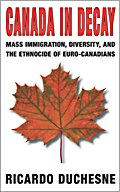Canada affected by human trafficking
Written by Amy Hadley,
The Ubyssey (University of British Columbia)
Wednesday, 2 January 2008
VANCOUVER (CUP) Students from Vancouver are taking action to help raise awareness and prevent human trafficking within Canadian borders.
Robin Pike is the executive director of British Columbia's Office to Combat Trafficking in Persons. She spoke to the University of British Columbia Human Trafficking Working Group about government action and inaction in fighting human trafficking in the recruiting, transferring, harbouring or receiving of people for the purpose of exploitation.
Law professor Benjamin Perrin started the Working Group in September 2007 with the aim of providing recommendations to the government.
He hopes to raise awareness of a problem rarely associated with Canada.
“Canada has one of the worst records in [the] developed world in terms of combating human trafficking, Perrin said.
Twelve law students now work with Perrin on the project. The group is examining different aspects of sexual exploitation.
Some students are studying Canada as a destination for trafficked people, and some are looking at Canada as a source country. Others are examining the transition of people through Canada to the United States.
The group is also studying the involvement of Canadians in sex tourism outside of the country.
Based on their analysis, Perrin hopes the team will be able to provide recommendations within two years on how the government should deal with the problem.The RCMP estimates that upwards of 1,200 people are trafficked into Canada each year, and about half of them are women brought in for sexual exploitation.
Labour exploitation is also a problem, Pike said, as is the using of trafficked people, including children, for drug smuggling.
Not all victims come from outside Canada, either. While domestic trafficking tends to fall under the radar, aboriginal women in particular are often victimized.
Vancouver is a hot spot, Pike said about trafficking, arguing that it will get worse leading up to the 2010 Olympics with the demand for cheap labour and sexual exploitation on the rise.
Perrin's volunteers do not receive academic credit for their effort, but without them research could cost upwards of a quarter million dollars.
According to Perrin, no human trafficking studies have been done in Canada to date and it is the volunteers that make this study possible.
The only paid member of Perrin's team is research assistant Jody Barber. The third-year law student was interested in human trafficking research before she joined the project, but even she didn't realize the extent of the problem in Canada.
Barber assumed she would be focusing on Thailand or Cambodia and said, “It didn't occur to me that I would focus on Canada.
Pike said that exploitation may be more visible in countries like Thailand and Cambodia, but Canadians need to realize that it is a big problem here too.
The establishment of her office in July 2007 was a good provincial initiative, she said. British Columbia is leading the country in efforts to stop human trafficking.
Other provinces are watching [B.C.], she said. Resources, however, are still tight in her office and adequate protection for victims isn't in place as Canada lacks a central organization to tackle the problem.
In Canada, human trafficking laws are relatively new and difficult to enforce.
Perrin explained this is partly because victims are often deported once discovered, and partly because there is no integrated law enforcement team dealing with the issue in the country.
While charges have been laid, there have not been any convictions yet under the 2002 Immigration and Refugee Protection Act.
More effort needs to be in prevention and enforcement, Perrin said.
Traffickers need to get a clear message that we're not open for business.
A 2006 UN report estimated that 800,000 people worldwide are trafficked annually. The majority of victims are women and girls.




